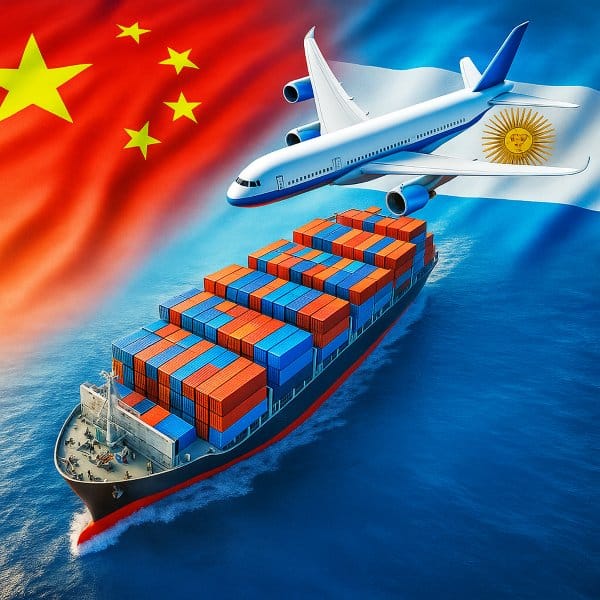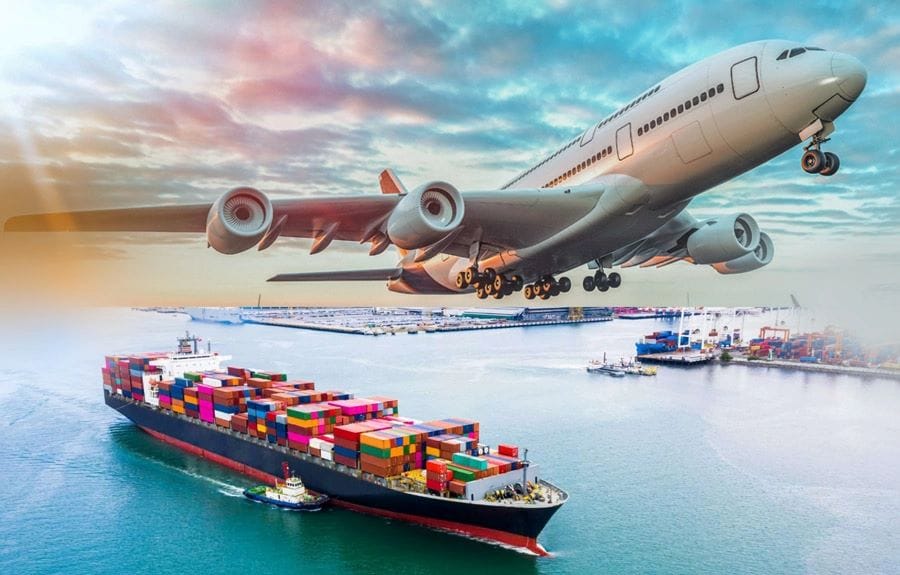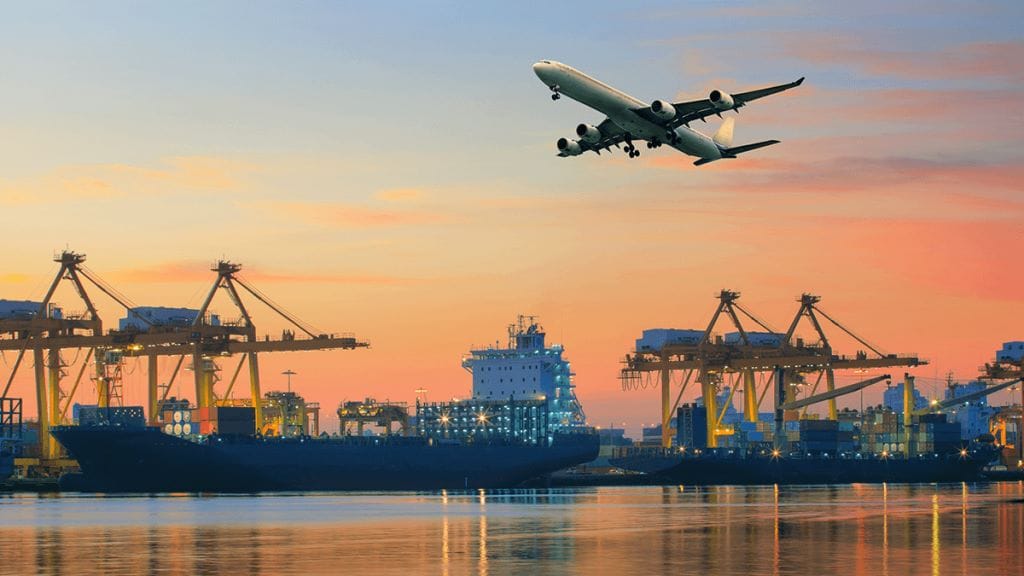The trade relationship between China and Argentina is getting closer and closer. As an important economy in Latin America, Argentina has a growing demand for Chinese products, covering multiple categories such as machinery and equipment, electronic products, textiles, auto parts and household goods. This article will explain the logistics and transportation between the two countries in detail.
Learn more: Shipping from China to Brazil

Sea Freight from China to Argentina
Sea Freight is the most common and economical mode of transportation from China to Argentina, suitable for large quantities of goods. You can choose full container load (FCL) or less than container load (LCL), mainly based on the size of the goods and budget:
Full container load (FCL)
Suitable for goods with a volume of more than one container (such as 20-foot or 40-foot containers), not sharing containers with others, high transportation efficiency and better safety. Loading is safe, timeliness is more stable, and the cost is calculated by full container load.
LCL (Less than Container Load)
When the cargo volume is less than a full container, you can choose LCL and share a container with other shippers. The cost is shared by volume/weight, which is low cost and suitable for small and medium-sized sellers.
Major Arrival Ports in Argentina
- Port of Buenos Aires: Argentina’s largest and busiest port, located in the capital. Handles most containerized imports.
- Port of Rosario: Rosario is located on the Paraná River and is an important hub for agricultural products and bulk cargo.
- Port of Bahia Blanca: A deepwater port in the south suitable for industrial cargo, chemicals and bulk cargo.
Choose Freight Forwarder and the Best Shipping Route
The right freight forwarder and efficient routes can maximize transportation efficiency, reduce logistics costs, and ensure that the goods arrive in Argentina on time and safely.
Choosing a trustworthy international freight forwarder is the first step to successful transportation. The following key factors can help you make a wise choice:
- Transparent and reasonable pricing: Pay attention to the level of freight quotes, compare whether it includes local pickup, customs clearance, destination port fees, etc., to avoid subsequent hidden costs.
- Reliability and reputation: Check whether the freight forwarder has many years of experience in operating from China to South America, especially Argentina. You can understand its strength by checking customer reviews, success stories, cooperative brands, etc.
- Customs clearance and compliance experience: Argentina has strict customs regulations on imported goods. It is recommended to choose a freight forwarder who is familiar with Argentina’s import policies and can assist you in preparing key documents such as invoices, packing lists, bills of lading, customs codes, etc. to avoid customs clearance delays or fines.
- Service capabilities and response speed: A high-quality freight forwarder should have the ability to quickly respond to customer needs, and be able to update the logistics status in time during transportation, handle emergencies, and provide full-process follow-up.
Main transportation routes
Choosing the right sea route will directly affect your timeliness and cost. The following are common transportation routes and route optimization suggestions from China to Argentina:
Conventional main routes
Starting from major Chinese ports (such as Shanghai, Ningbo, Shenzhen, Qingdao), stopping at Singapore, Malaysia or other transit ports, then crossing the Panama Canal into the Atlantic Ocean, and arriving at Buenos Aires, the main port of Argentina.
Direct routes or express services
Some shipping companies may provide relatively direct “express” services to reduce the number of transit times and speed up the overall transportation timeliness.
Port selection suggestions
It is recommended to choose the export port closest to the warehouse according to the place of shipment to reduce inland transportation costs. Pay attention to whether the destination port Buenos Aires is congested. If necessary, other auxiliary ports in Argentina can be considered for transit delivery.
Air Freight from China to Argentina
Air freight is suitable for goods with high timeliness requirements, high value or small volume. It has high reliability and consistent flight schedules to ensure predictable delivery dates. It is very suitable for perishable goods, electronic products, pharmaceuticals, and items that need to be delivered quickly and handled carefully, which is limited by the type of goods (such as liquids and batteries).
Major cargo airports in Argentina
- Ministro Pistarini International Airport (EZE): Argentina’s main international gateway, handling most air cargo.
- Buenos Aires Jorge Newbery Airport (AEP): Serves mainly domestic and regional flights, but also handles some international cargo.
- Cordoba International Airport (COR): An important airport in central Argentina, supporting regional and some international air cargo.
Choose the Right Air Freight Forwarder
In order to ensure that air transportation from China to Argentina is fast, efficient and worry-free, it is crucial to choose an experienced and thoughtful air freight forwarder.
Wide network coverage
Air freight forwarders should have operating networks or long-term partners in both China and Argentina and have practical operational capabilities. Realize pickup and palletizing in China, customs clearance and delivery services in Argentina.
Professional knowledge and compliance experience
In China-Argentina trade, Argentina’s import policies and customs clearance procedures are relatively complex. It is particularly important to choose an agent with the following capabilities:
- Proficient in customs regulations of both countries, air transport restrictions (such as batteries, liquids, perishable goods, etc.)
- Familiar with professional content such as ATA documents, freight insurance, and pre-declaration requirements
- Can assist in preparing complete documents: commercial invoice, packing list, air waybill (AWB), certificate of origin, etc.
- Ubestshipping provides dedicated follow-up services to assist customers in preparing various documents and assess customs clearance risks in advance to avoid additional costs or delays.
Reasonable price and timeliness guarantee
- When choosing an air freight agent, you can customize a flexible quotation plan based on your cargo type, destination and service needs.
- The specific cost is affected by factors such as route, space availability, and cargo attributes (such as whether it is oversized/overweight).
- Prices may fluctuate during peak seasons or special periods (such as Black Friday and Christmas season). It is recommended to book space in advance.
Shipping Cost from China to Argentina
The cost of shipping from China to Argentina depends on the mode of transportation, cargo volume/weight, origin and destination, whether customs clearance and delivery are included, etc. It is also affected by the following factors:
- Additional service fees: such as pickup, palletizing, customs clearance, insurance, delivery, warehousing, etc.
- Nature of goods: sensitive goods (such as batteries, liquids, powders) require special handling and are more expensive
- Peak season or tense period: such as Christmas and Black Friday Eve, shipping costs generally rise.
The following is a rough range of shipping costs to help you provide reference:
| Shipping Mode | Description | Cost Estimate |
| LCL (Less than Container Load) | Perfect for smaller shipments, priced by volume | $200-$300 USD per cubic meter |
| FCL (Full Container Load) – 20-foot | Best for large shipments, budget-friendly | $3,350 – $4,000 USD per container |
| FCL (Full Container Load) – 40-foot | Ideal for substantial shipments, cost-effective | $4,650 – $6,650 USD per container |
| Air Freight | Quick and efficient, costed by weight/volume | $9.65 USD per kilogram |
In addition to the above shipping costs, there are usually the following fees. Knowing the details will ensure that you can effectively estimate and budget your shipping costs.
- Insurance costs: Usually about 0.5% of the value of the goods.
- Tariffs: In Argentina, tariffs are generally 10-20% of the value of the goods, and the specific amount varies depending on the product.
- VAT: Argentina imposes a 21% VAT on imported goods.
| Product Category | Customs Duty | VAT |
| Electronics | 16% | 21% |
| Clothing | 35% | 21% |
| Machinery | 14% | 21% |
| Toys | 35% | 21% |
| Agricultural Products | 0-10% | 21% |

Cost of Shipping 20ft and 40ft Container from China to Argentina
Container shipping from China to Argentina is the mainstream mode of transportation. In addition to the different costs according to size (20ft and 40ft containers), there are also large differences between different ports of departure to different ports in Argentina:
| POL (Port of China) | POL (Port of Brazil) | 20ft Container Cost | 40ft Container Cost |
|---|---|---|---|
| Shanghai | Buenos Aires | $3300 – $400 | $4200 – $5800 |
| Shenzhen | Buenos Aires | $3300 – $4000 | $4200 – $6000 |
| Ningbo | Buenos Aires | $3400 – $3900 | $4100 – $5700 |
| Shanghai | Rosario | $3200 – $4000 | $4500 – $6200 |
| Shenzhen | Rosario | $3100 – $4000 | $4100 – $6300 |
| Ningbo | Rosario | $3350 – $3900 | $4100 – $5800 |
| Shanghai | Bahia Blanca | $3400 – $3950 | $4200 – $6000 |
| Shenzhen | Bahia Blanca | $3500 – $3900 | $4400 – $6200 |
| Ningbo | Bahia Blanca | $3300 – $4000 | $4200 – $5800 |
Shipping Time from China to Argentina
Shipping time is an important consideration when choosing a logistics solution. Choosing the right mode of transport depends on the urgency and nature of the goods, and is also affected by a variety of factors:
- Weather conditions: Bad weather can disrupt sea and air freight plans.
- Port congestion: Busy ports can slow down the loading and unloading process.
- Customs delays: Complex customs procedures can extend shipping time.
- Logistics efficiency: Delays in warehousing or local distribution services can affect overall shipping time.
Below are typical shipping times for different modes of transport to help you plan effectively:
| Shipping Mode | Typical Transit Time | Considerations |
| Sea Freight (LCL) | 30-50 days | Cost-effective for bulk shipments that aren’t urgent. |
| Sea Freight (FCL) | 30-40 days | Perfect for large, secure shipments. |
| Air Freight | 5-10 days | Ideal for high-value or perishable items. |
Shipping Process from China to Argentina
The main modes of transportation from China to Argentina are sea and air, and different modes of transportation are suitable for different types of goods, budgets, and time requirements. Choosing the right mode of transportation can not only save costs, but also improve the efficiency of cargo distribution. Understanding the following processes will help with transportation:

Inquiry and booking
- Contact a freight forwarder: Contact a reliable logistics provider to discuss your transportation needs.
- Choose the type of service: Determine full container load (FCL) or less than container load (LCL), or air freight based on the shipment volume.
- Confirm booking: Complete the booking and receive a bill of lading (B/L) number for tracking.
Cargo preparation
Ensure that the goods are securely packed in crates, pallets, or reinforced boxes to protect them during transportation. Clearly label the consignee details, handling instructions, and special notices for fragile or dangerous goods.
Document preparation
Prepare necessary shipping documents, including:
- Commercial Invoice: describes the value, quantity, and type of goods.
- Packing List: details the weight, dimensions, and contents of the goods.
- Bill of Lading (B/L): a contract and receipt for goods issued by a shipping line.
- Certificate of Origin: used to verify the origin of goods and determine applicable tariffs.
- Special License: required for regulated or hazardous materials.
Pickup and Transport to Port of Departure
Arrange to pick up goods from the Chinese supplier and transport the goods to the port of departure or airport (such as Shanghai, Shenzhen) for customs clearance and loading.
China Export Customs Clearance
- Document Submission: Submit all required documents to the Chinese customs authorities.
- Customs Inspection: Customs officials may inspect the goods to verify that they comply with export regulations.
- Customs Clearance: Once approved, the goods can be loaded on the ship.
Loading and Shipping
Load the goods into containers for full container shipments or combine with other goods for LCL shipments. Select the goods to be loaded on the designated aircraft for shipment to Argentina.
Arrival in Argentina
The goods arrive at the designated port or airport in Argentina (for example, the Port of Buenos Aires). Unload the goods from and transport them to the customs warehouse for customs clearance.
Argentina import customs clearance
Provide bill of lading, commercial invoice, packing list to Argentina customs. Pay applicable import duties (usually 10-15%) and VAT (21%) based on the CIF value of the goods. Customs officials inspect the goods before releasing them.
Final delivery to destination
Arrange transportation of the cleared goods to the consignee’s location in Argentina.
Shipping from China to Argentina is an intercontinental supply chain activity involving logistics, regulations, cost management and other aspects. By choosing the right mode of transportation, arranging a reasonable transportation plan, ensuring customs clearance compliance, and having a reliable international freight forwarding partner, the goods can be transported smoothly to Argentina.
